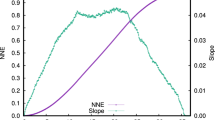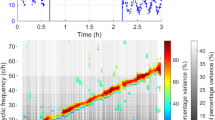Abstract
The technique of surrogate data analysis may be employed to test the hypothesis that an observed data set was generated by one of several specific classes of dynamical system. Current algorithms for surrogate data analysis enable one, in a generic way, to test for membership of the following three classes of dynamical system: (0) independent and identically distributed noise, (1) linearly filtered noise, and (2) a monotonic nonlinear transformation of linearly filtered noise.
We show that one may apply statistics from nonlinear dynamical systems theory, in particular those derived from the correlation integral, as test statistics for the hypothesis that an observed time series is consistent with each of these three linear classes of dynamical system. Using statistics based on the correlation integral we show that it is also possible to test much broader (and not necessarily linear) hypotheses.
We illustrate these methods with radial basis models and an algorithm to estimate the correlation dimension. By exploiting some special properties of this correlation dimension estimation algorithm we are able to test very specific hypotheses. Using these techniques we demonstrate the respiratory control of human infants exhibits a quasi-periodic orbit (the obvious inspiratory/expiratory cycle) together with cyclic amplitude modulation. This cyclic amplitude modulation manifests as a stable focus in the first return map (equivalently, the sequence of successive peaks).
Similar content being viewed by others
References
Abarbanel H.D.I., Brown R., Sidorowich J.J., and Tsimring L.S. 1993. The analysis of observed chaotic data in physical systems. Reviews of Modern Physics 65: 1331-1392.
Casdagli M.C., Iasemidis L.D., Sackellares J.C., Roper S.N., Glimore R.L., and Savit R.S. 1996. Characterizing nonlinearity in invasive EEG recordings from temporal lobe epilepsy. Physica D 99: 381-399.
Ding M., Grebogi C., Ott E., Sauer T., and Yorke J.A. 1993. Plateau onset for correlation dimension: when does it occur? Physical Review Letters 70: 3872-3875.
Farmer J.D., Ott E., and Yorke J.A. 1983. The dimension of chaotic attractors. Physica D 7: 153-180.
Galka A., Maaß T., and Pfister G. 1998. Estimating the dimension of high-dimensional attractors: A comparison between two algorithms. Physica D 121: 237-251.
Grassberger P. and Procaccia I. 1983. Measuring the strangeness of strange attractors. Physica D 9: 189-208.
Guckenheimer J. and Holmes P. 1983. Nonlinear oscillations, dynamical systems, and bifurcations of vector fields, Volume 42. Applied Mathematical Sciences. Springer-Verlag, New York.
Ikeguchi T. and Aihara K. 1997. Estimating correlation dimensions of biological time series with a reliable method. Journal of Intelligent and Fuzzy Systems 5: 33-52.
Judd K. 1992.Animproved estimator of dimension and some comments on providing confidence intervals. Physica D 56: 216-228.
Judd K. 1994. Estimating dimension from small samples. Physica D 71: 421-429.
Judd K. and Mees A. 1995. On selecting models for nonlinear time series. Physica D 82: 426-444.
Kennel M.B., Brown R., and Abarbanel H.D.I. 1992. Determining embedding dimension for phase-space reconstruction using a geometric construction. Physical Review A 45: 3403-3411.
Noakes L. 1991. The Takens embedding theorem. International Journal of Bifurcation and Chaos 1: 867-872.
Priestly M.B. 1989. Non-Linear and Non-Stationary Time Series Analysis. Academic Press, London.
Rissanen J. 1989. Stochastic Complexity in Statistical Inquiry. World Scientific, Singapore.
Schmid G.B. and Dünki R.M. 1996. Indications of nonlinearity, intraindividual specificity and stability of human EEG: the unfolding dimension. Physica D 93: 165-190.
Schreiber T. and Schmitz A. 1996. Improved surrogate data for nonlinearity tests. Physical Review Letters 77: 635-638.
Small M. and Judd K. 1997. Using surrogate data to test for nonlinearity in experimental data. International Symposium on Nonlinear Theory and its Applications,Volume 2, Research Society of Nonlinear Theory and its Applications, IEICE, pp. 1133-1136.
Small M. and Judd K. 1998a. Comparison of new nonlinear modelling techniques with applications to infant respiration. Physica D 117: 283-298.
Small M. and Judd K. 1998b. Detecting nonlinearity in experimental data. International Journal of Bifurcation and Chaos 8: 1231-1244.
Small M. and Judd K. 1998c. Pivotal statistics for non-constrained realizations of composite null hypotheses in surrogate data analysis. Physica D 120: 386-400.
Small M. and Judd K. 1999. Detecting periodicity in experimental data using linear modeling techniques. Physical Review E 59(2) pp. 1379-1385.
Small M., Judd K., Lowe M., and Stick S. 1999. Is breathing in infants chaotic? Dimension estimates for respiratory patterns during quiet sleep. Journal of Applied Physiology 86: 359-376.
Small M., Judd K., and Stick S. 1996. Linear modelling techniques detect periodic respiratory behaviour in infants during regular breathing in quiet sleep. American Journal of Respiratory Critical Care Medicine 153: A79. (abstract).
Takens F. 1981. Detecting strange attractors in turbulence. Lecture Notes in Mathematics 898: 366-381.
Takens F. 1993. Detecting nonlinearities in stationary time series. International Journal of Bifurcation and Chaos 3: 241-256.
Theiler J. 1990. Estimating fractal dimension. Journal of the Optical Society of America A 7: 1055-1073.
Theiler J. 1995. On the evidence for low-dimensional chaos in an epileptic electroencephalogram. Physics Letters A 196: 335-341.
Theiler J., Eubank S., Longtin A., Galdrikian B., and Farmer J.D. 1992. Testing for nonlinearity in time series: the method of surrogate data. Physica D 58: 77-94.
Theiler J. and Prichard D. 1996. Constrained-realization Monte-Carlo method for hypothesis testing. Physica D 94: 221-235.
Theiler J. and Rapp P. 1996. Re-examination of the evidence for low-dimensional, nonlinear structure in the human electroencephalogram. Electroencephalography Clinical Neurophysiology 98: 213-222.
Vibe K. and Vesin J.-M. 1996. On chaos detection methods. International Journal of Bifurcation and Chaos 6: 529-543.
Waggener T.B., Brusil P.J., Kronauer R.E., Gabel R.A., and Inbar G.F. 1984. Strength and cycle time of high-altitude ventilatory patterns in unacclimatized humans. Journal of Applied Physiology 56: 576-581.
Author information
Authors and Affiliations
Rights and permissions
About this article
Cite this article
Small, M., Judd, K. & Mees, A. Testing Time Series for Nonlinearity. Statistics and Computing 11, 257–268 (2001). https://doi.org/10.1023/A:1016604405201
Issue Date:
DOI: https://doi.org/10.1023/A:1016604405201




